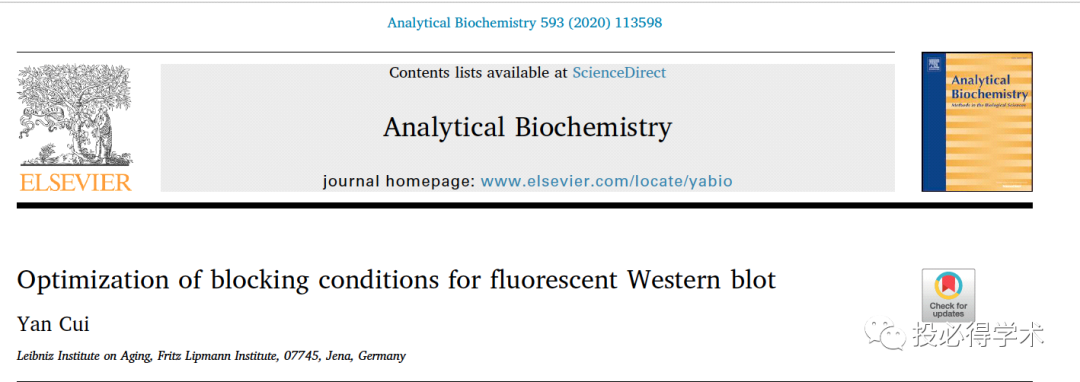分析生物化学领域容易发“短平快”的文章,如果小伙伴们急着发第一篇SCI文章,着急毕业,你实在应该考虑下分析生物化学。最近,小编又发现了一个“短平快”的文章,题为“Optimization of blocking conditions for fluorescent Western blot”,更令人瞠目结舌的是,这篇文章只有一个作者,只是摸索了一个条件,发了一篇IF 2.4(Analytical biochemistry)的文章。下面小编分解下这篇文章,主要从写法上面分析。

这篇文章的标题是标准的分析化学领域标题,没有(也不需要)故事性:在XXX方面优化XXXX条件。
第一句 “locking conditions are critical for reducing background and non-specific signals in Western blot (WB)”, 框定大范围(Western blot);第二句“For fluorescent WB, however, blockers may bring in additional autofluorescence, and optimal blocking conditions have been less well established”,缩小范围 (fluorescent WB),并指出问题 “XXXX have been less well established”。紧接着列举“results”。最后干脆利落地总结下,“This work provides a reference for cost-effective blocking conditions for fluorescent WB。”
作者直入正题,先称赞fluorescent WB 很常用,很好;以及fluorescent WB的分类。然后迅速转折,“fluorescent WB often suffers xxxxx”。紧接着,作者指出解决办法,“ Blocking conditions are critical for XXXXXX ”,提到了目前的现状,“Currently, there are mainly two types of imagers”。再次,作者简明扼要地介绍了“results”,用的方式是“In this work, XXXX were systematically investigated,XXXXXX, revealing that XXXXX”。最后,总结“High auto fluorescent background can be avoided by choosing a proper blocker for a given detection channel”.
常规写法,“不求出彩,但求详细”,多采用一般过去时被动式。例子如下:
五看“Results” and “Discussion”。
“Results”写得非常详细,从3.1写到了3.17,很少遇到这样的作者和文章。“Discussion”也总结得很细致。由于小编尚未思索清楚如何和大家讨论,暂时不详谈。
作者先总结了下问题,“The background in a fluorescent WB is much more complex than in a chemiluminescent WB, including both the autofluorescent background and the background caused by non-specific binding of the antibodies to the membrane.” 然后再说自己优化过的参数。最后,不温不火的来了句,实在不行就换个常规方法吧。
分析生物化学是一门由分析化学和生物化学组成的交叉学科,其目的就是通过各种条件优化来提高检测方法的特异性和敏感性。这篇文章主要是提高检测的敏感性(通过降低噪音的方式)。此外,该文只有一个作者。小编查了下,是来自德国Leibniz Graduate school的中国籍研究人员 Yan Cui。Yan Cui应该是一位博后,主要研究方向是神经科学。为了解决自己的试验问题,TA特意优化了荧光WB的试验条件,顺便发表了篇SCI文章,增加了自己的Publication。在这篇文章中,Yan Cui自己设计试验,自己动手试验,自己写作,独立发表,并且是唯一作者。



